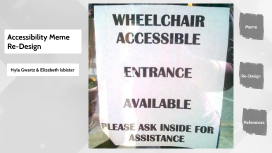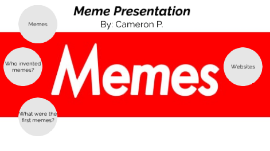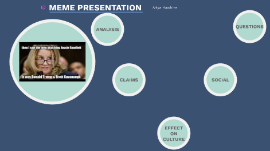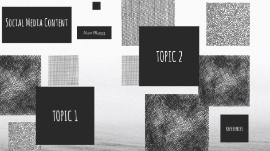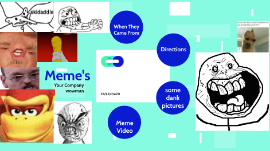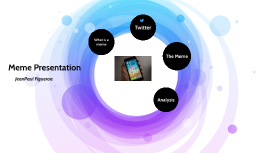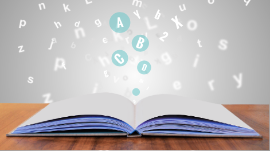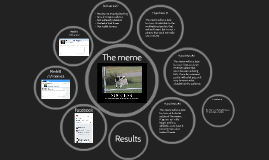Meme Presentation
Transcript: By: Cameron P. Meme Presentation Memes have emerged as one of the main methods of communications in the real world and on the internet. Whether they’re being shared by your favorite celebrities, your friends, or your family, memes have been a very popular thing throughout the 21st century. It became so popular that anything nowadays can become a meme—even people, and if you’re really lucky, becoming a meme can turn you into a celebrity. Memes Memes Back then, memes were just weird pictures that you would find online made to entertain you and others. Now, we find memes all over social media almost every minute. What are memes? What are memes? Usually, people on the internet can take something as random as the children’s show Arthur and turn clips and images from it into memes, or mock the entire concept of people having and using Airpods. How can a meme be made? How can a meme be made? The real question is, what can’t become a meme? According to an analysis by Smithsonian Magazine, memes can be anything as monumental as a belief in God to catch phrases or idioms to a type of music or song. The generally understood definition of a meme today is anything that’s a joke on the internet, usually wrapped in a layer of sarcasm or irony. Memes can be image, video, or text based, and can be reproduced, republished, or reinterpreted by others, leading to an entirely different message. What can become a meme? What can become a meme? Richard Dawkins first created the term “meme” in 1976, in his book, The Selfish Gene. In this first iteration, the idea was that ideas and thoughts were as self-replicating and adapting as the genes found within all forms as DNA. This adds up, given the way memes today are re-imagined and reformatted. Who invented memes? Who invented memes? Once upon a time, memes were an obscure form of early internet humor, finding early homes in various forums and sites like 4chan. With limited content creation tools, early memes revolved around singular pictures and concepts: "I Can Has Cheezburger?" cats is an example of the early memes. What were the first memes? What were the first memes? What followed were top text/bottom text memes, featuring a picture either on a colored pinwheel background or a humorous photo with a single sentence, two-step punchline: Philosoraptor would ask life’s meaningless questions. Top Text/Bottom Text Top Text/Bottom Text In 2007, memes took on a new lifeform: videos. Looking outside of picture-based memes, the concept of Rick Rolling became a recognized phenom, and was one of the first video-based instances of humor being passed around the internet. All of these early memes found their home on 4chan and then started to filter out onto Tumblr, where they began to reach almost-mainstream status. Video Videos Gallery of Memes Gallery of Memes Meme Research - https://www.complex.com/pop-culture/2019/03/evolution-of-memes/ Meme images - https://www.youtube.com (Channel Name: Scoop) and Google Images. Rick Roll Video (Never Gonna Give You Up) - https://www.youtube.com/watch?v=dQw4w9WgXcQ Websites I used Websites






